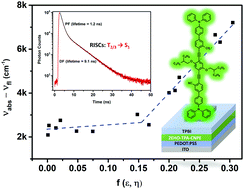A hybridized local and charge transfer excited state for solution-processed non-doped green electroluminescence based on oligo(p-phenyleneethynylene)†
Abstract
We herein report a new highly efficient green emissive hot-exciton molecule, 1,4-bis((4′-diphenylamino-3-cyano-[1,1′-biphenyl]-4-yl)ethynyl)-2,5-bis(2-ethylhexyloxy)benzene (2EHO-TPA-CNPE) that consists of an extended D′–π′–A–π–D–π–A–π′–D′ molecular π-system with diphenylamino end units (D′) and ethynylene/phenylene spacers (π/π′). The new molecule exhibits high photoluminescence (PL) quantum efficiencies (ΦPL = 0.95 (solution) and 0.45 (spin-coated neat thin-film)), and a strong PL solvatochromic behavior revealing significant changes in excited state energies/characteristics (locally excited (LE) → hybridized local and charge transfer (HLCT) → charge-transfer (CT)) depending on solvent polarity. Highly efficient (radiative exciton yield (ηr) = 50–59% ≫ 25%) green-emitting OLEDs were fabricated in a conventional device architecture by employing (non-)doped thin-films reaching a maximum current efficiency (CEmax) of 12.0 cd A−1 and a maximum external quantum efficiency (EQEmax) of 5.5%. The emission profile of the non-doped OLED has CIE 1976 (u′, v′) chromaticity coordinates of (0.10, 0.55) corresponding to a night vision imaging system (NVIS) compatible Green A region. 2EHO-TPA-CNPE-based OLED devices of industrial relevance were also fabricated by ink-jet printing the emissive layer and by fabricating an inverted architecture, which possessed respectable device performances of 2.4–6.1 cd A−1. The solid-state solvation effect in OLED devices yields HLCT electronic behavior resulting in high ηr's, which is confirmed by TDDFT to originate from energetically/spatially favorable reverse intersystem crossings (RISCs) (T2/3 → S1). As a unique observation, delayed fluorescence due to this RISC was evident in the PL decay lifetime measurement with a ns-scale lifetime of ∼10 ns. These results clearly allow a better understanding of the structure–photophysical property–electroluminescence relationships in this new class of oligo(p-phenyleneethynylene)-based hot-exciton molecules, and it could open up new opportunities for high-performance solution-processed optoelectronic/sensing applications.



 Please wait while we load your content...
Please wait while we load your content...